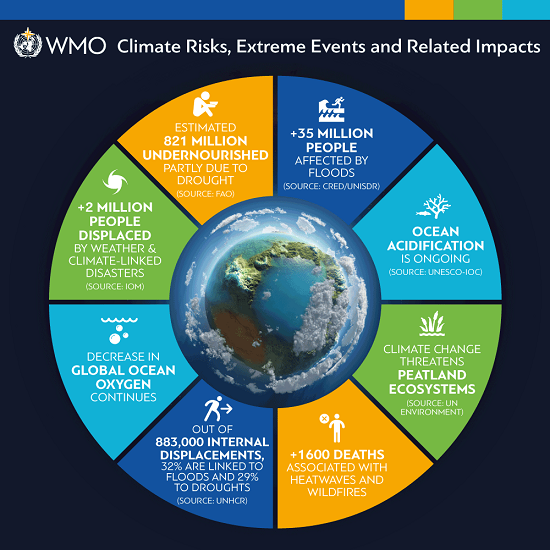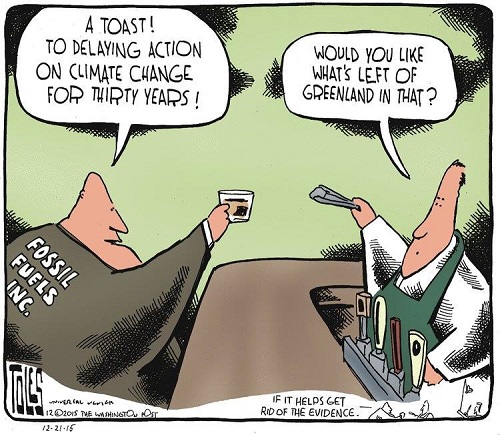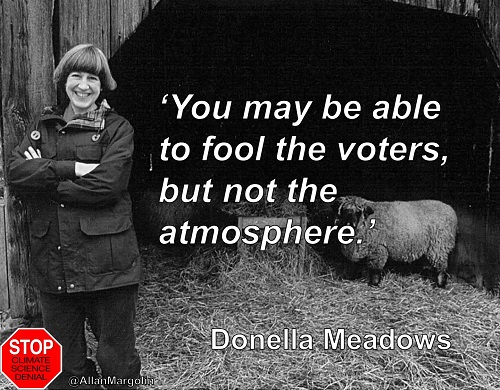2019 SkS Weekly Climate Change & Global Warming Digest #13
Posted on 31 March 2019 by John Hartz
Story of the Week... Toon of the Week... Video of the Week... Coming Soon on SkS... Climate Feedback Reviews... SkS Week in Review... Poster of the Week...
Story of the Week...
State of the Climate in 2018 shows accelerating climate change impacts

The physical signs and socio-economic impacts of climate change are accelerating as record greenhouse gas concentrations drive global temperatures towards increasingly dangerous levels, according to a new report from the World Meteorological Organization.
The WMO Statement on the State of the Global Climate in 2018, its 25th anniversary edition, highlights record sea level rise, as well as exceptionally high land and ocean temperatures over the past four years. This warming trend has lasted since the start of this century and is expected to continue.
“Since the Statement was first published, climate science has achieved an unprecedented degree of robustness, providing authoritative evidence of global temperature increase and associated features such as accelerating sea level rise, shrinking sea ice, glacier retreat and extreme events such as heat waves,” said WMO Secretary-General Petteri Taalas.
These key climate change indicators are becoming more pronounced. Carbon dioxide levels, which were at 357.0 parts per million when the statement was first published in 1994, keep rising – to 405.5 parts per million in 2017. For 2018 and 2019, greenhouse gas concentrations are expected to increase further.
The WMO climate statement includes input from national meteorological and hydrological services, an extensive community of scientific experts, and United Nations agencies. It details climate related risks and impacts on human health and welfare, migration and displacement, food security, the environment and ocean and land-based ecosystems. It also catalogues extreme weather around the world.
“Extreme weather has continued in the early 2019, most recently with Tropical Cyclone Idai, which caused devastating floods and tragic loss of life in Mozambique, Zimbabwe and Malawi. It may turn out to be one of the deadliest weather-related disasters to hit the southern hemisphere,” said Mr Taalas.
“Idai made landfall over the city of Beira: a rapidly growing, low-lying city on a coastline vulnerable to storm surges and already facing the consequences of sea level rise. Idai’s victims personify why we need the global agenda on sustainable development, climate change adaptation and disaster risk reduction,” said Mr Taalas.
The start of this year has also seen warm record daily winter temperatures in Europe, unusual cold in North America and searing heatwaves in Australia. Arctic and Antarctic ice extent is yet again well below average.
According to WMO’s latest Global Seasonal Climate Update (March to May), above average sea surface temperatures – partly because of a weak strength El Niño in the Pacific – is expected to lead to above-normal land temperature, particularly in tropical latitudes.
State of the Climate in 2018 shows accelerating climate change impacts, WMO Press Release, Mar 28, 2019
Toon of the Week...

Video of the Week...
The Sun delivers more energy to Earth in one hour than all of humanity uses in an entire year. How can we make this power more accessible to everyone, everywhere? Solar designer Marjan van Aubel shows how she's turning everyday objects like tabletops and stained glass windows into elegant solar cells — and shares her vision to make every surface a power station.
This talk was presented to a local audience at TEDxAmsterdamWomen, Dec 2018
Coming Soon on SkS...
- Asteroid to hit Earth in August 2046 - Emergency IPCC UN panel formed (scaddenp)
- Protecting oil companies instead of the climate-vulnerable is elitist (Dana)
- Why results from the next generation of climate models matter (Stephen Belcher, Olivier Bucher & Rowan Sutton)
- Three decades of climate national defense warnings (Dana)
- New research this week (Ari)
- 2019 SkS Weekly Climate Change & Global Warming News Roundup #14 (John Hartz)
- 2019 SkS Weekly Climate Change & Global Warming Digest #14 (John Hartz)
Climate Feedback Claim Review...
Blaze article badly misrepresents study of Greenland’s Jakobshavn Glacier
CLAIM
"[O]ne of the previously fastest shrinking glaciers in the world is growing again, calling into question the narrative that rapid climate change [...] poses a significant threat to the existence of the human race"
VERDICT
![]()
SOURCE
New study shows one of world's largest glaciers is actually growing — not shrinking by Chris Enloe, The Blaze, 26 March 2019
DETAILS
Fails to grasp significance of observation: A temporary re-advance of a glacier driven by variability of ocean currents is not a reversal of the long-term, human-caused trend of warming and ice loss.
Flawed reasoning: Observing the multi-faceted behavior of an individual glacier does not enable one to conclude that global climate change is not dangerous.
KEY TAKE AWAY
This claim badly misrepresents a study showing that a temporary movement of cooler ocean water against Greenland's Jakobshavn Glacier caused the previously retreating ice to re-advance slightly. The study does not, in any way, imply that global climate change and sea level rise are not dangerous. It simply illustrates the local effects that glaciologists study in order to understand all the factors that can affect individual glaciers.
Blaze article badly misrepresents study of Greenland’s Jakobshavn Glacier, Edited by Scott Johnson, Claim Reviews, Climate Feedback, Mar 29, 2019
Poster of the Week...

SkS Week in Review...
- 2019 SkS Weekly Climate Change & Global Warming News Roundup #13 by John Hartz
- New research, March 18-24, 2019 by Ari Jokimäki
- The Green New Deal debate is in part about the absence of details by Bud Ward (Yale Climate Connections)
- Major study uncovers ‘sea change’ in world’s understanding of Atlantic conveyor belt by Daisy Dunne (Carbon Brief)
- 3 clean energy myths that can lead to a productive climate conversation by Karin Kirk (Yale Climate Connections)
- 2019 SkS Weekly Climate Change & Global Warming Digest #12 by John Hartz































 Arguments
Arguments






























Comments